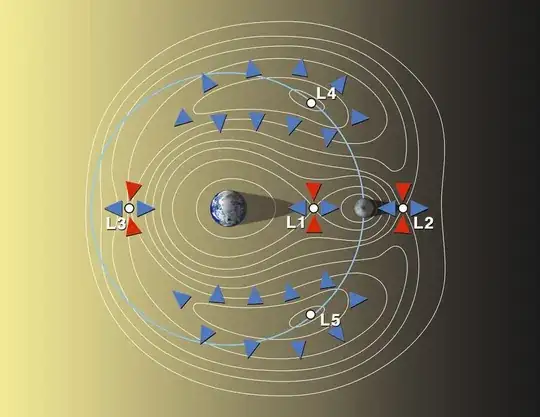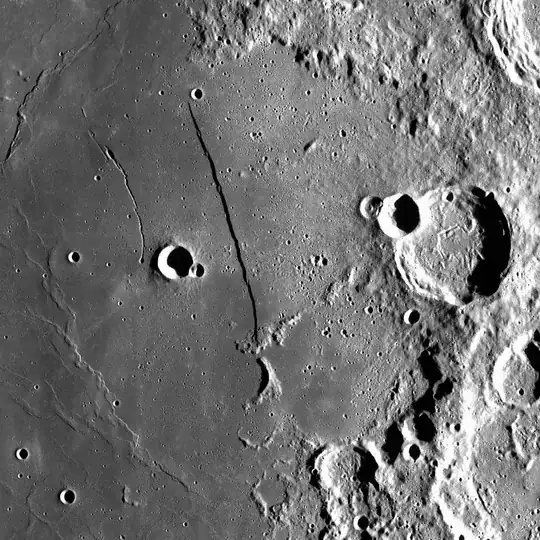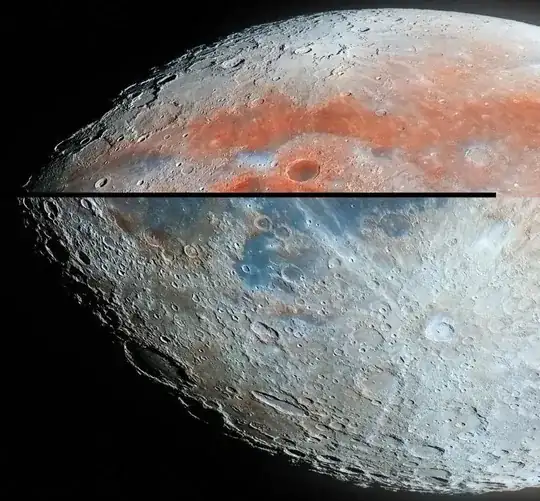If we had a very powerful telescope with say a 150-meter diameter, placed in orbit around earth, would it be possible to get a side view rather than a top view of a person standing on the moon?
-
17Size of the telescope has no bearing on whether the view you get is top-down or side on. A larger telescope just allows you to see more detail from the same angle. It's the position of your target on the surface of the moon and the position of your telescope that determines the orientation of what's in the image. – notovny Sep 11 '22 at 20:11
-
@notovny Considering the Earth-moon system, would there be such a configuration at a certain time as to allow a side view? – William Sep 11 '22 at 20:15
-
2Where in orbit about the Earth? LEO? GEO? Further out? Unless it's much further out than GEO, I would say the answer is no. – David Hammen Sep 12 '22 at 09:48
-
@DavidHammen Thank you David but some of the answers below doesn't seem to agree with you. – William Sep 12 '22 at 19:47
-
Data point: Look at good quality high resolution images of the Moon. Look at the edges of the disk - you'll see they are rough, not smooth. That's the lunar lanscape seen side on. You can see some mountains / large craters quite clearly. – Russell McMahon Sep 14 '22 at 07:28
-
@RussellMcMahon that's an issue of location on the lunar surface, not power of the telescope. – Christopher James Huff Sep 14 '22 at 13:30
-
@ChristopherJamesHuff To seem someone "from the side" you need to view them side on. This occurs, as others have noted, when they are "on a limb" - where limb is the whole circle edge at full moon. The edge on terraqin shows the principle. The other answers indicate how refraction sets a limit. – Russell McMahon Sep 15 '22 at 01:22
-
@RussellMcMahon The answers based on diffraction are only confusing the issue: if you are viewing them from the side, you don't even need a telescope. There is no limit. If you are not viewing them from the side, it doesn't matter how powerful your telescope is. – Christopher James Huff Sep 15 '22 at 13:51
6 Answers
Yes.
The person just has to be standing somewhere near the limb of the moon. That is near the edge of the apparent disc of the moon.
We see everything near the limb of the moon from the side, at all times. This is because the moon is (roughly) a sphere. It's not flat.
- 120,702
- 5
- 298
- 423
-
2
-
2
-
29
-
-
1Probably, depending on what you mean by "horizon", but from the perspective of Earth, "limb" is the correct word. See https://astronomy.stackexchange.com/questions/49600/name-for-the-boundary-between-near-and-far-sides-relative-to-an-observer/49601#49601 – James K Sep 12 '22 at 18:32
-
@Barmar They are the same. You never see the moon rotate, you always see the same side from Earth, therefore it must be flat. If the moon is flat, then the earth also must be. – rtaft Sep 12 '22 at 19:50
-
3@Criggie Since the Moon is tidally locked, it makes sense to talk about a near side and a far side of the Moon. So another way to say the person should stand near the limb, would be to say that the person should stand near or in the "border region" between the near side and the far side. – Jeppe Stig Nielsen Sep 13 '22 at 12:20
-
@Barmar Nope! - they tend to believe everything we see in the sky is a sphere(oid), except for the ground because that's not in the sky. Also the sun is like 4000 miles away and orbits in circles above the atmosphere by magic. – user253751 Sep 13 '22 at 18:49
-
@Barmar IIRC, early NASA missions modeled the flight with a flat earth. Certainly not that usable with Apollo 10 onward. – chux - Reinstate Monica Sep 14 '22 at 05:20
-
1@chux-ReinstateMonica how can one model an orbit using a flat-Earth approximation? Orbiting requires moving full 360°, flat-Earth approximation must break down in this case. – Ruslan Sep 14 '22 at 12:15
-
1@chux-ReinstateMonica I think even artillary calculations at anything other than point-blank range requires taking earth curvature into effect. So I doubt they could really use that simplification in space flight. OTOH, if you're calculating driving distance, the winding of the roads will usually have more significance than earth curvature. – Barmar Sep 14 '22 at 14:52
-
-
1@DrakeP such a model has no predictive power. It might only be useful for a video game, not for flight control. – Ruslan Sep 14 '22 at 18:45
Yes, but only just. The best-case (called "diffraction-limited") angular resolution of a telescope (i.e. the smallest detail it can make out) is given by $$ \theta = 1.22 \frac{\lambda}{D} $$ Where $\lambda$ is the wavelength of light you're observing in (say, 500nm for visible light) and $D$ is the diameter of the telescope. With a 150m diameter, this is $4 \times 10^{-9}$ radians.
Multiply that by the distance to the moon (400,000km) to get the smallest resolvable detail: 1.6m, only just big enough to see an astronaut. They would appear as a tiny white dot.
This is an absolute best-case scenario — luckily, real space telescopes tend to get pretty close to the diffraction limit.
- 389
- 2
- 2
-
10In fact, this means that it's easier to see them from the side. From directly overhead you would need to be able to resolve about half that. – Barmar Sep 12 '22 at 14:59
-
If the 150m telescope can resolve down to 1.6m, doesn't that mean we still could see the astronaut if s/he was standing near the limb of the moon, as suggested by James K's answer? – William Sep 12 '22 at 19:38
-
5@Barmar, depends on the contrast. If something is significantly brighter or significantly darker than the surroundings, you can see it even if it's below the diffraction limit. (See, for example, the stars: every one of them is far below the diffraction limit for your eye.) – Mark Sep 13 '22 at 00:39
-
3So if SpaceX landed a Starship on the limb, that would be relatively easy to spot. Best. Photo. Ever. – DrMcCleod Sep 13 '22 at 09:53
-
@DrMcCleod: It could be another interesting question : how big should the telescope be in order to see at least a few pixels worth of Starship landing on the moon? – Eric Duminil Sep 13 '22 at 15:08
-
1@EricDuminil: Starship HLS is approximately 50 meters by 9 meters. So if it was right at the limb, you'd need about a 500 mm (20 inch) diameter scope to get an image of roughly 1x6 pixels. Looking at it "head on" you'd need roughly a one meter scope to get a 2x2 pixel image (in both cases, assuming a high contrast between the HLS and the background). – Jerry Coffin Sep 13 '22 at 16:51
-
-
4@EricDuminil: I should add that (much like Steve's answer) that's the theoretical limit. For an earth-based telescope, the atmosphere places a much lower limit on available resolution. – Jerry Coffin Sep 13 '22 at 17:31
would it be possible to get a side view rather than a top view of a person standing on the moon
It's kind of possible to do both at the same time. Simply wait for the person to be at the lunar terminator. As seen from the moon, the sun will be so low on the horizon that the shadow of the person can get really long:
Your powerful telescope will not be able to resolve the head from above, but might resolve a few pixels of the shadow.
This is also the reason why you see different craters on the moon every day : you don't see the ones in the shadow, you don't see much detail at all when they're completely sunlit, but you see very crisp details of the craters that are along the terminator.
This "wall" on the moon is only visible during a few hours every month, for example, when the incoming light has just the correct angle:
- 1,365
- 8
- 15
-
1I love it! I also love how the regolith looks a bit brighter around the edges of the figure's shadow due to shadow hiding/opposition surge – uhoh Sep 12 '22 at 21:40
No, assuming you want to see that the thing you are observing is a human as opposed to a rock.
Steve R beat me to this answer based on the diffraction limit of a telescope. To distinguish between a human and a rock, the telescope would need to be able to have a resolution of 20 centimeters, the size of a human head. Using the Raleigh criterion for the resolution of a telescope, $$\theta \approx 1.22 \frac{\lambda}{D}$$ where $\theta$ is the angular resolution of the telescope, $\lambda$ is the wavelength of the electromagnetic radiation being received (I'll use 600 nanometers), and $D$ is the diameter of the mirror.
Using the small angle approximation, if $d_1$ is the distance between the telescope and the object of interest, and $d_2$ is the size of the object, we want $$\theta d_1 < d_2$$ or $$d1 < \frac{d_2 D}{1.22 \lambda}$$
Plugging in the numbers ($d_2 = 20\,\text{cm}$, $D = 150\,\text{m}$, $\lambda = 600\,\text{nm}$) yields a distance between the telescope and subject of no more than 41000 km. That's orbiting the Moon rather than the Earth.
- 33,900
- 3
- 74
- 125
-
4Actually, you probably wouldn't need anywhere as good resolution as 20 cm to distinguish a person from a rock: if she's wearing a bright and/or coloured spacesuit, it will be obvious even in an image that's blurred over 5 m. What you couldn't do is distinuish her from a piece of equipment of the same colour. – leftaroundabout Sep 12 '22 at 12:59
-
How large would the telescope need to be to allow this? Easier to build a bigger telescope than to move the moon close to earth. ;) – AnoE Sep 12 '22 at 14:37
Summary:
To see someone "from the side" you need to view them side on. This occurs, as others have noted, when they are "on a limb" - where limb is the whole circle edge at full moon. The edge on terrain in the images below shows the principle. Other answers indicate how refraction sets a limit to the smallest size of an image which can be viewed.
You can see the equivalent now.
Look at good quality high resolution images of the Moon.
Look at the edges of the disk - you'll see they are rough, not smooth. That's the lunar lanscape seen side on. You can see some mountains / large craters quite clearly.
Here you can find A "lower res" version of the highest resolution available. The full resolution version is 11022 x 11022 pixels - but it costs money.
This is a crop of the top left and bottom left corners of a medium resolution showing side on detail.
.
- 141
- 6
Using an orbit that get close to the Moon regularly can be an option and you can take photos while they are close together, but that still have a huge impact on the orbit in a long run.
But at least once you'll be able to do such picture. I guess you can go quite close to the Moon without any harm to the telescope as it doesn't have real atmosphere, but this will change the telescope's orbit totally.
L2 Lagrange point seems much closer to Moon than the Earth, but I guess it's still not close enough.

The Lagrange points for the Earth-moon system. Credit: David A. Kring, LPI-JSC Center for Lunar Science and Exploration
- 123
- 3
-
This is the only answer that actually comes close to answering the question. All of the discussion of diffraction limits/the limb of the moon/etc is a distraction. It doesn't even need to be a particularly powerful telescope provided it comes close enough, it just needs to be to the side of the person it's imaging...who will of course then appear near the limb of the moon from the vantage point of that telescope. If it's not to the side, a more powerful telescope isn't going to help. – Christopher James Huff Sep 14 '22 at 13:47


